The article “Which Gulf do they mean?” by Kourosh Ziaberi originally appeared in the LobeLog on August 7, 2019. Kindly note that excepting one image, all other images and accompanying descriptions do not appear in the original release posted on LobeLog. The version printed below has been edited from the original version.
========================================================================================
If you’ve ever wondered how historical realities can be sacrificed and manipulated in the service of myopic political goals, there is a great example for you to follow in your daily roundup of international news offered by the mainstream media.
While reading through coverage of current Middle Eastern affairs in international newspapers, magazines, and news websites, it’s very common for readers to come across the words “the Gulf.” Many people recognize what “the Gulf” signifies, but many others don’t know and get perplexed and still others ignore the vague reference while reading. Basically, the phrase is meant to denote the body of water separating Iran from the Arabian Peninsula. By accident, the sea has got a name of its own and is called the “Persian Gulf.” But there are many reasons why it is becoming customary for the mass media to identify it simply as “the Gulf,” leaving critical audiences astounded why the expanse of water is not called by its full name, unlike multiple other geographic entities that are allowed the use of their full names.
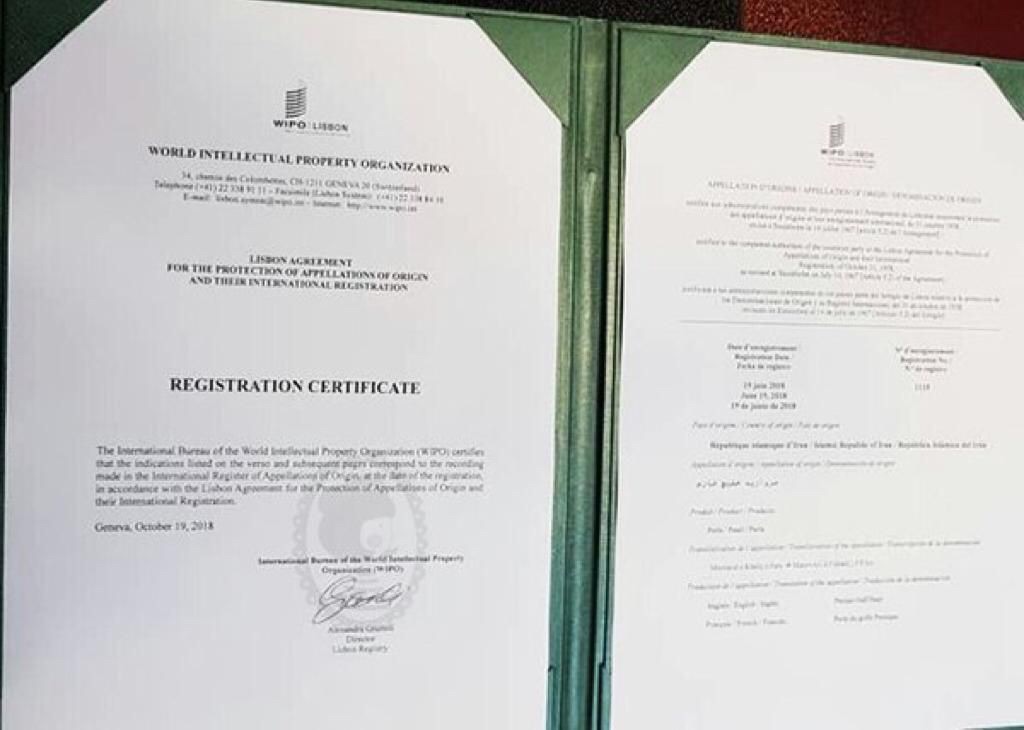
WIPO Registration certificate attesting to the correct historical body of water known as the Persian Gulf (Source: Mohammad Ala) … for more see Here … This is the first official registration at WIPO (which is a UN body). There have been two other previous declarations (UNAD 311 of 5 March 1971 and UNLA 45.8.2(c) of 10 August 1984) affirming the correct name for the Persian Gulf. WIPO has re-affirmed the legality of this term as (unfortunately) politically motivated outlets have continued using fabricated terminology. You may refer to the following articles for more information:
- کاوه فرخ (۱۳۸۳/2004). میراث پان عربیسم. اطلاعات سیاسی-اقتصادی, شماره ۲۰۹-۲۱۰, صفحه ۴-۱۵ – Farrokh, K. (2004). The Legacy of pan-Arabism. Ettelaat Siyasi-Eqtesadi[Political-Economic Information], Number 209-210, pp.4-15.
A Vital Waterway
The Persian Gulf is a vital waterway that is an extension of the Indian Ocean through the Strait of Hormuz, which is considered by the U.S. Energy Information Administration “the world’s most important strategic chokepoint for oil transport.” The earliest evidence of human life on islands in the Persian Gulf dates back to the Middle Paleolithic Period, spanning from 300,000 to 30,000 years ago. Inhabitants around the Persian Gulf in ancient times are believed to be the first people to use fish as food.
University of Birmingham researchers believe the land that now lies beneath the Persian Gulf might have been host to humans over 100,000 years, before it was swamped by the Indian Ocean around 8,000 years ago.
Oil was found in the Persian Gulf in 1908. However, it was not until the 1903s when major discoveries were made. It’s reported that more than 50% of the world’s oil reserves lie in and around the Persian Gulf. Moreover, about a third of the world’s liquefied natural gas passes through the Strait of Hormuz, the narrow water lane connecting the Persian Gulf and the Sea of Oman.
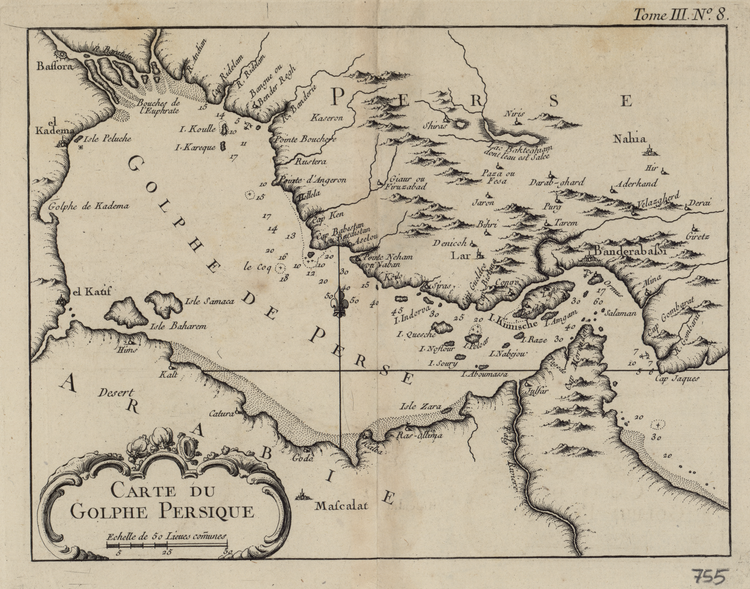
Map of the Persian Gulf by 18th century French cartographer Jacques-Nicolas Bellin (Source: LobeLog).
Sir Arnold Talbot Wilson, the British civil commissioner in Baghdad from 1918-20, wrote in a book published in 1928, “No water channel has been so significant as Persian Gulf to the geologists, archaeologists, geographers, merchants, politicians, excursionists, and scholars whether in past or in present. This water channel which separates the Iran Plateau from the Arabia Plate, has enjoyed an Iranian Identity since at least 2,200 years ago.”
The Persian Gulf has been a hotbed of economic development in recent years. The 2005-2015 expansion of the economies of Persian Gulf states—mostly Saudi Arabia, the UAE, Kuwait, Oman, Qatar, and Bahrain—persuaded millions of migrants to move to the region in search of economic opportunities. According to a Pew Research Center study, the number of non-displaced, international migrants living in the Middle East rose from 19 to 31 million in that ten-year period.
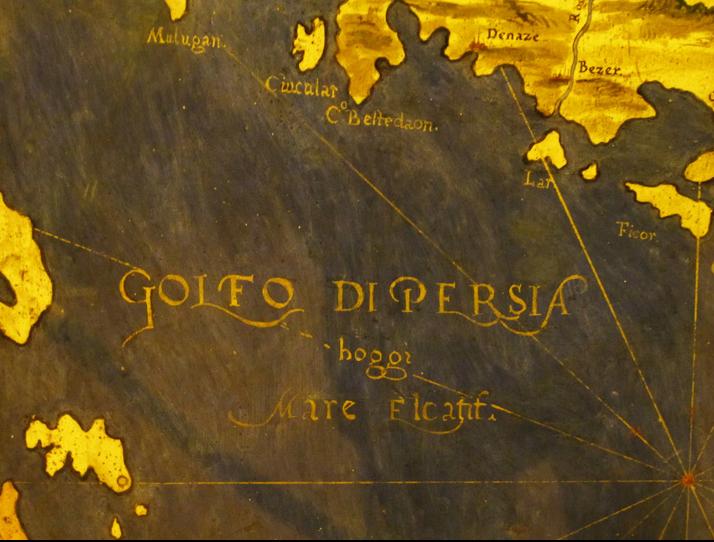
Florence 16th Century Map of Persia which cites ” G o l f o d i P e r s i a”. For more see … “Iran and the Persian Gulf”
Due to its enormous gas and oil resources and its strategically important position, the Persian Gulf has been an arena of rivalry between the world’s major powers since the mid-19th century, when British India, Tsarist Russia, and the Ottoman Empire faced off there.
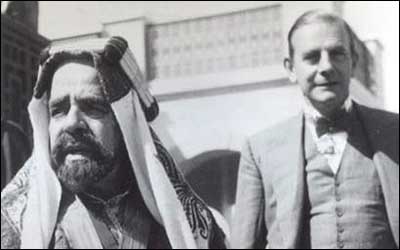
Shaikh Salman Bin Hamad Al-Khalifa (at left) and Sir Charles Belgrave (right) (Picture Source: Flicker) who was England’s Government Advisor to Bahrain. It was Belgrave who first pioneered the concept of changing the name of the Persian Gulf. The motives for such revisionist schemes remain unclear, but it is possible that Belgrave and the British policymakers may have calculated that such actions would create frictions between the Iranians and the Arabs. For more on this topic see … “Pan-Arabism and it’s Legacy of Confrontation with Iran“
What’s in a Name?
For a number of reasons, the Persian Gulf epitomizes Iranian national identity and is highly significant to the Iranian people. The most important reason is Iran’s historical sovereignty over the body of water and that the majority of countries that surround the Gulf today were once parts of the Persian Empire, when the Achaemenid Dynasty was in power. Therefore, it’s not difficult to decipher the strong passion Iranians feel about the Persian Gulf. Today, Among the Persian Gulf’s eight littoral states, Iran has the longest coastline and the largest population. The largest island in the Persian Gulf is Iran’s Qeshm Island.
Countless historical documents identify the body of water as the Persian Gulf, and there is unanimity over the historicity and validity of the name. Greek geographers Strabo, who lived in the Augustan era, and Ptolemy, who lived in the 2nd century CE, used the name “Persian Gulf” in their maps.
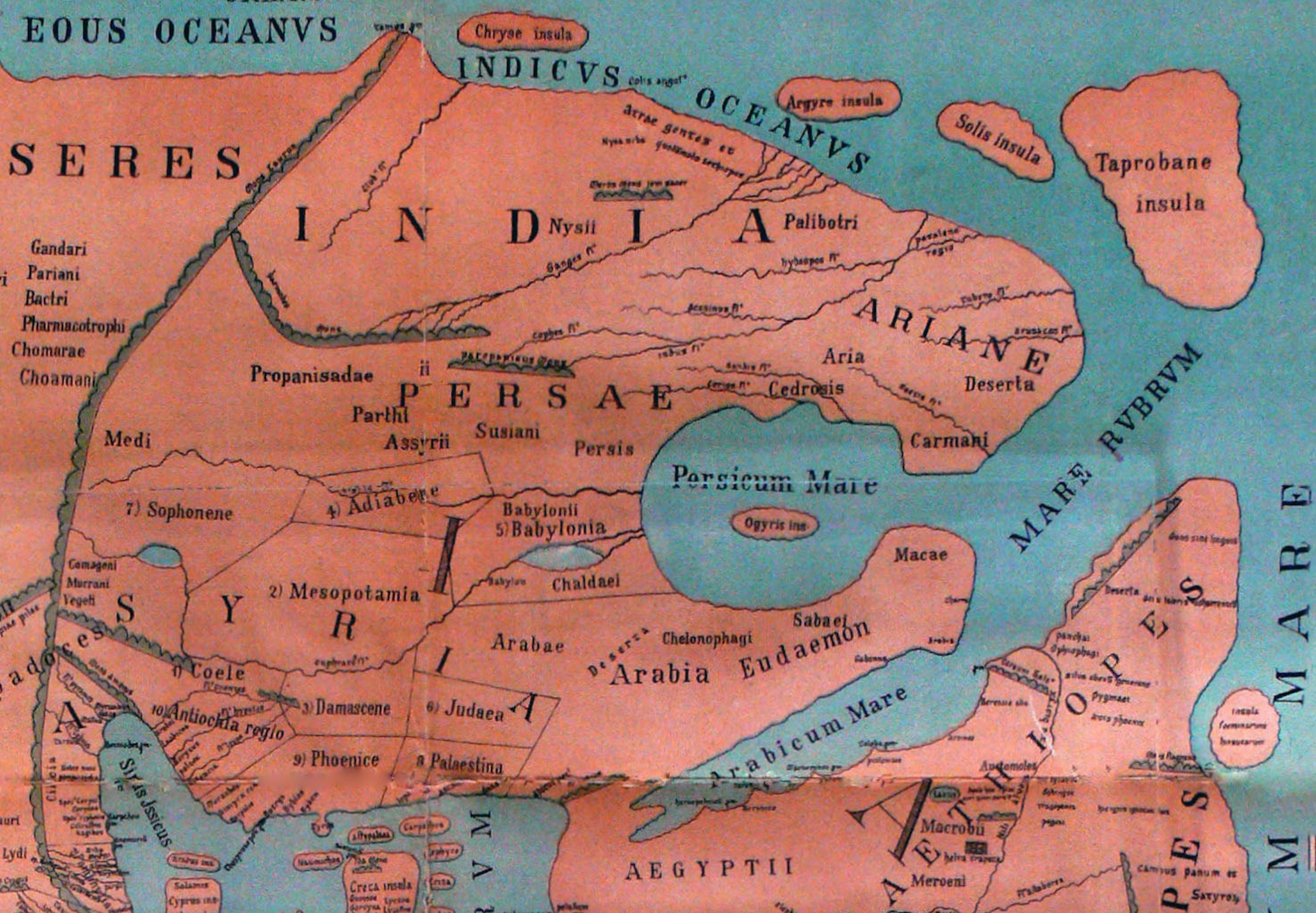
Close-up of a Rotated Map by Pomponius Mela (originally drafted in 43 CE) reproduced in Mappa Mundi by Konrad Miller in 1898 (Bild Vi. “Rekonstruierte Karten”, Tafel 7 [Picture Vi, Reconstructed Maps, Plate 7]) (Photo of image: Public Domain). The designation “Persicum Mare” (Persian Sea) is clearly and historically attested upon the map.
Today, the United Nations only recognizes the name Persian Gulf and issued two editorial directives in 1994 and 1999, clarifying its position on the naming of the waterway.
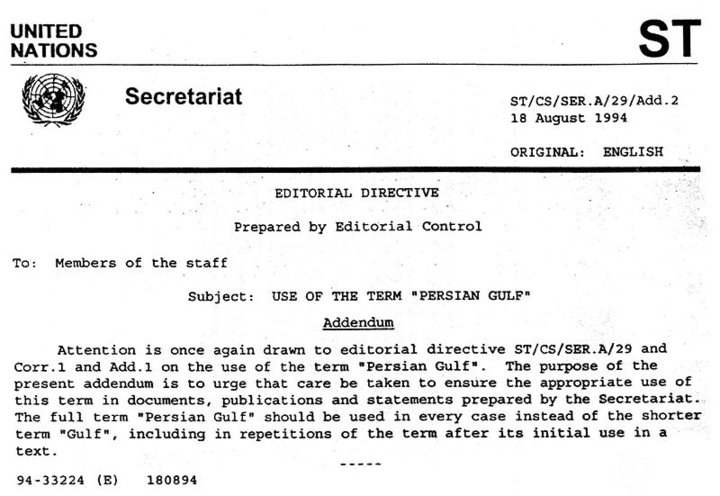
United Nations Editorial Directive issued on August 18, 1994 which clearly notes of the legality and correct use of the name “Persian Gulf”. For more see … “Jamal Abdul Nasser’s Reference to the Persian Gulf on August 30, 1951”
The declining influence of Iran following the 1979 revolution, and the growth of pan-Arab sentiments and Arab nationalism since the early 1960s precipitated the coinage of the term “Arabian Gulf” as a replacement for a name that has been in use commonly for hundreds of years. The Eighth United Nations Conference on the Standardization of Geographical Names in 2002 concluded that the name Arabian Gulf is “faulty.”
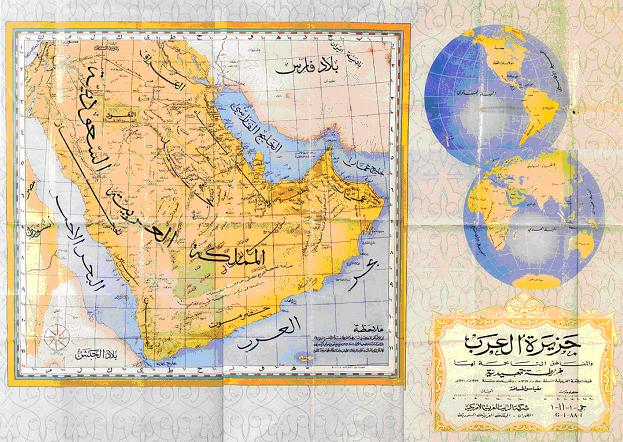
Saudi Arabian ARAMCO map printed in 1952. This map identifies the historical name of the body of water separating Iran from the Arabian Peninsula as the Persian Gulf (Source: posted in Persian Gulf On-line). For more see … “1952 Saudi Arabian map of the Persian Gulf”
These days, certain governments and media organizations see the distortion of the name “Persian Gulf” as a safe and inexpensive shortcut to chip away at Iran while the Islamic Republic is in conflict with the West over the nuclear crisis and a number of other sticking points. For some media outlets, identifying the Persian Gulf as “the Gulf” or “Arabian Gulf” is a matter of pandering to their well-off benefactors in the Arab world, and for some of them, it’s all about demoralizing Iran by deliberately shrugging off a historical reality.
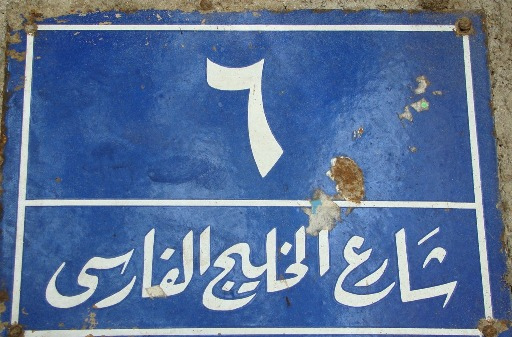
The street plaque “Sharraa Khalij al-Faris” (Persian Gulf Street) in Cairo, Egypt (Source: posted in Persian Gulf On-line). For more see … “Jamal Abdul Nasser’s Reference to the Persian Gulf on August 30, 1951”
Indisputably, when a country is diplomatically and politically fragile, its assets and resources will be accordingly at stake, and its rivals will race to take its belongings away. The tendency of international media and certain world governments and politicians to call the Persian Gulf as “the Gulf” or even go the extra mile to call it the “Arabian Gulf” is one of the offshoots of Iran’s growing isolation in recent years over its much-debated nuclear program and its controversial regional policies.
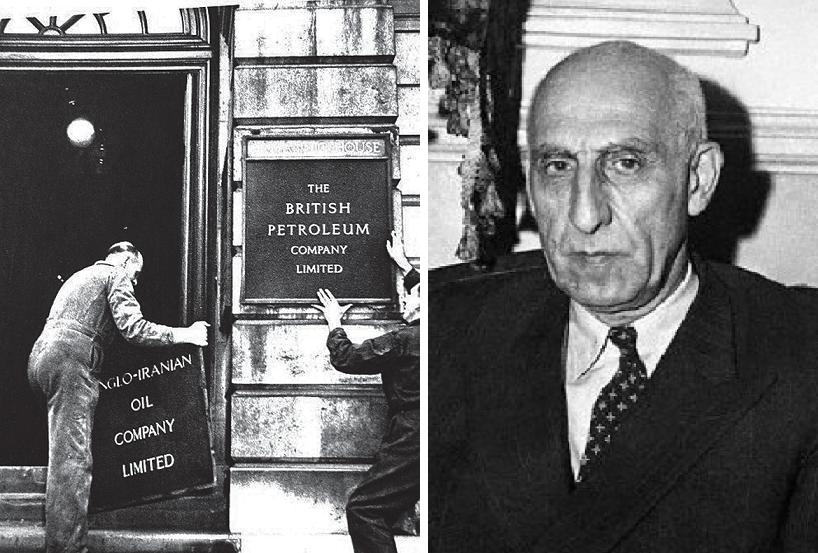
Different name – same management: Anglo-Iranian Oil Company or AIOC (Anglo-Persian Oil Company until 1935) changes its title to British Petroleum (BP) in 1954 (at left). One year before its name change (1953) the petroleum company had been instrumental in cooperating with the CIA to topple Iranian Prime Minister Mossadegh (1882-1967) (at right) – for more information consult Iran at War: 1500-1988, 2011, pp. 297-303. At present, BP has major oil interests in the Caucasus to the north of Iran.
However, it’s safe to argue that those in the media who tamper with a geographical name rooted in history don’t simply kowtow to a political agenda. They betray the conscience of their audience and promote fake information. Altering the name of the Persian Gulf does not simply translate to debilitating Iran. It’s equivalent to undermining a shared heritage of mankind and trampling its identity underfoot.
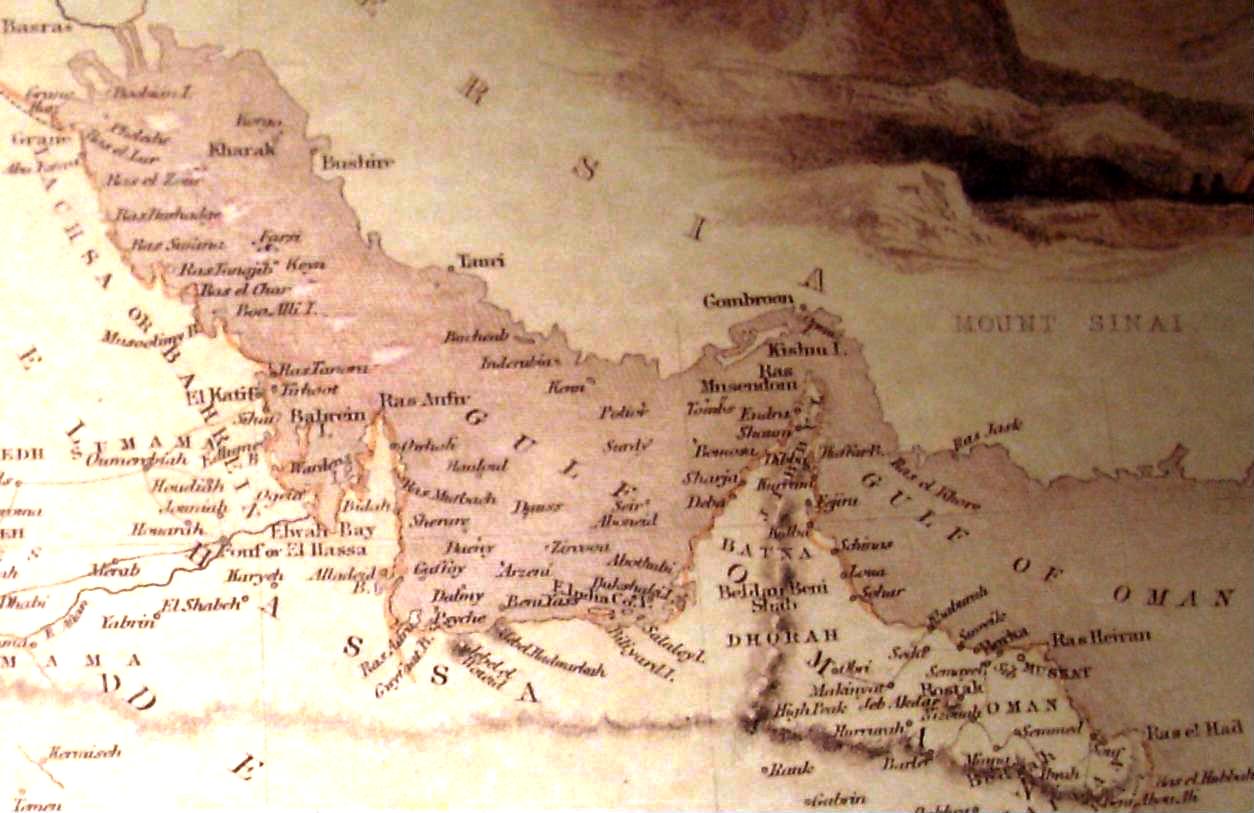
A historical map with the name “Persian” literally erased from the designation “Persian Gulf”, to leave only the invented term “Gulf”. This falsified map is housed in Dubai’s Saeed Al Maktoum House in the United Arab Emirates (UAE). Interestingly the UAE along with several modern day states in West Asia, excluding the historical states of Turkey and Iran, were created in the 20th century. States such as the UAE and Saudi Arabia for example, were literally created in large part due to the Anglo-European economic and geopolitical engineering policies. Buttressing such policies are additional Anglo-European 20th century inventions such as “The Middle East” … for more see:
There are numerous geographical regions whose names are taken from the nearby countries—for example, the Indian Ocean, the Gulf of Mexico and the South China Sea. The world would be a terrible place if the political nemeses of these countries attempted every day to concoct a new name for those entities in order to fulfill short-term political goals.
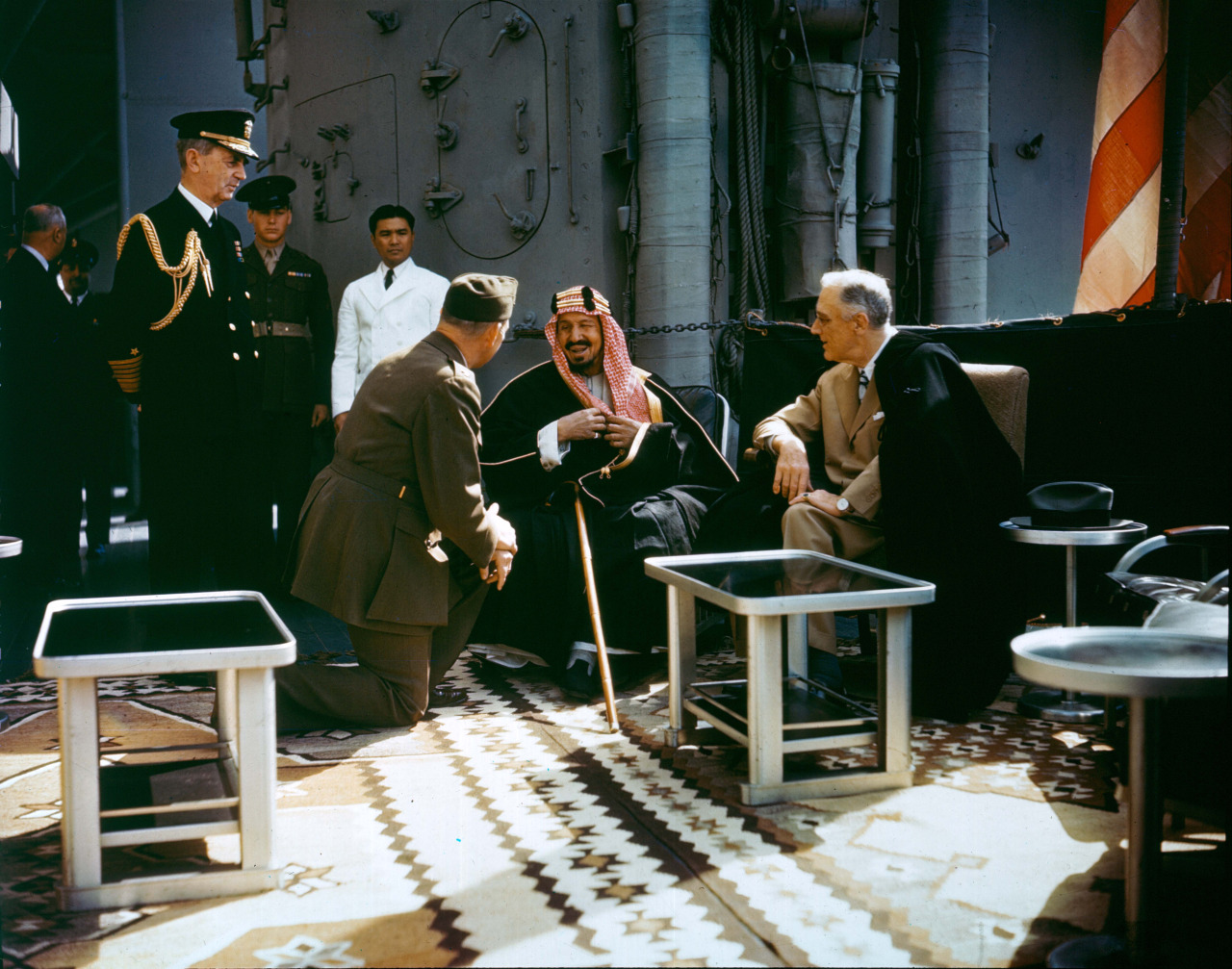
King Abdulaziz ibn Abdul Rahman Al Saud (reigned 1932-1953) meeting with US President Franklin D. Roosevelt (1882-1945) (at right) aboard the US warship, USS Quincy, after the Yalta Conference (Feb. 4-11, 1945) (Source: Public Domain). The interpreter is Colonel Bill Eddy with Fleet Admiral William D. Leahy located to the left. Ibn Saud is on record for his racist statement “…we hate the Persians…” (Allen, 2006, p.245; God’s Terrorists: The Wahhabi Cult and the Hidden Roots of Modern Jihad, Abacus: London). Western statesmen and business lobbyists to the present day continue to ignore these types of attitudes among non-European leaders in favor of lucrative commercial and geopolitical interests. For more on this topic see … “Pan-Arabism and it’s Legacy of Confrontation with Iran“



